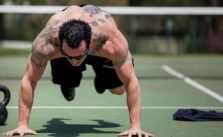Push Press: Part of New First Responder Program by mike stefano
March 14, 2014 | by abidine

In this article I’m targeting both first responders and kettlebell lifters, as we examine the One-Arm Push Press. The Push Press is a great way to break into kettlebell lifting, as the technical demands aren’t as high as for Jerk or Snatch. But don’t sell the Push Press short, it can be a viable asset to any kettlebell routine, and has been specifically selected as a major player in my new First Responder Kettlebell Program.
The powerfully explosive heave that’s necessary in Push Press is a perfect match to the way a firefighter typically generates force when performing forcible entry or building overhaul, two very demanding physical activities that as a first responder, I encountered regularly.
Like all movements covered by the ECKC, everything is based on teachings of the AKC the Fedorenko Method. Kettlebell lifting, when done with proper technique, represents a unique way to engage in specific high intensity exercise with relatively little impact and breakdown of the body. A rare distinction that allows continual progress forward, without the typical setback of injuries, associated with many fitness protocols.
The Push Press is where the kettlebell lifter moves the kettlebell from the Rack Position (chest/shoulder level) to the Overhead Lockout. Both Rack and Lockout present opportunities for rest and recovery, enabling much longer, more productive sets. Push Press can teach the new lifter a lot about these two integral parts of kettlebell lifting.
RACK
The Rack Position is where the bell is held preparing for a Press, Push Press or Jerk. A workable Rack is very much effected by the lifters body composition, flexibility and skill. The rack can be broken down to six points, previously covered in detail.
SIX POINTS OF RACK
- Bell handle lies diagonally across palm, weight on Hip of Palm
- Fingers are tucked behind handle, except index finger
- Elbow is on hip ready to “launch” bell
- Arm is rotated to create perfect nest for bell
- Knees are straight with hips forward
- Wrist is not flexed
LOCKOUT
In lockout, the bell sits upon the same spot on the Hip of the Palm, with the bell handle still diagonally across the palm. If shoulder flexibility permits, the arm, with locked elbow, passes directly next to the ear, kind of stacking the bones of the arm, shoulder, and back, making the most of gravity to help support the kettlebell. The bell, ideally, is held slightly behind the head, with chest leaning slightly forward. The stance is strong, yet relaxed.
LAUNCHING PAD
As we move to the Push Press, the functionality of the Rack Position to provide a launching pad for the kettlebell becomes obvious. If a proper rack is achieved, the elbow of the lifting arm will be connected to the hip, perched atop the illiac crest of the pelvis. The forearm, spearheaded by the elbow, should be driving downward into the hip bone, preparing the for upward heave.
FIRST AND ONLY DIP
But let’s not get ahead of ourselves. As we stand in rack, preparing to launch the bell, we first need to dip, to drop a few inches, increasing our ability to pop back up and complete the Push Press. Many people make a crucial mistake here, they don’t drop a few inches down, the squat with muscle control. In the initial dip, let gravity do it’s job, catch yourself and pop immediately back up, keeping the feet flat on the floor. The bell will drive up magically if done correctly, and you’ll have to finish (push) the press with upper body effort to lockout. Be sure to inhale as the bell is driven upward.
THE DROP
At lockout, rest a moment and DROP the bell back to the rack, as you exhale. Literally, with as little muscle effort as possible, allow the arm to fold back into rack. Use your body (dipping and hips and knees slightly) to help absorb the blow. You can also allow the bell so sort of brush along your shoulder (make sure to wear a cotton tee shirt for this reason) as it settles into position.
RELATED POSTS
View all


